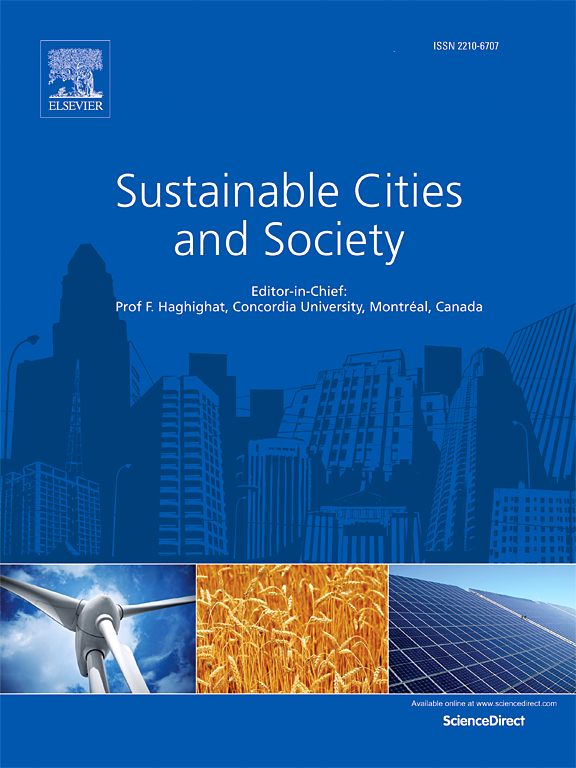How to classify microclimates more validly and finely? A novel method for mapping local climate zone (LCZ) on micro-scales
IF 10.5
1区 工程技术
Q1 CONSTRUCTION & BUILDING TECHNOLOGY
引用次数: 0
Abstract
Global climate change and rapid urbanization are driving microclimate variations in urban areas, intensifying the formation of urban heat islands (UHIs) vulnerable to extreme weather. The local climate zone (LCZ) framework, using remote sensing (RS) and geographic information system (GIS), has advanced with the World Urban Database and Access Portal Tool (WUDAPT), enabling microclimate understanding for improved urban planning and climate adaptation. However, mapping LCZs at the micro-scale relies on locally available GIS data or RS imagery, data gaps, authenticity issues, and low-resolution imagery often lead to inaccurate microclimate classifications. To enhance the validity and sophistication of microclimate classification, this study introduces a novel method for mapping LCZ using unmanned aerial vehicle (UAV) photogrammetry at the micro-scale (LCZ-UAV-MS), which constructs detailed land use and land cover (LULC) and 3D real scene (3DRS) models, calculates urban surface parameters (USPs) for each basic spatial unit (BSU) through spatial statistical analysis, and employs a decision-making classifier to categorize each BSU. This study validates the proposed method using Gulangyu as the study area, employing image overlay, temperature observation, and expert knowledge, with the following results: 1) Spatial percentage showing 51 % natural environments (LCZ A, B, C, and D), 27 % neutral environments (LCZ 7, 8, 9, 10, and Y), and 22 % built environments (LCZ 1, 2, 3, 4, 5, and 6) in Gulangyu. 2) The variance in mean LST across different LCZs was 1.02 in January and 5.18 in August 2024, with temperature differences more pronounced in summer, where the built environment had a higher mean LST of 41.3 °C compared to 35.2 °C in the natural environment and 38.3 °C in the neutral environment. 3) Field research at 22 random sample sites showed that 95 % of LCZ-UAV-MS classifications matched the field, outperforming WUDAPT LCZ, which matched only 10 %. These demonstrate that the LCZ-UAV-MS accurately captures microclimate temperature variations and provides a more precise micro-scale description than the WUDAPT LCZ. This study bridges the gap of LCZ studies in specific regions and scales, enhances the applicability of the LCZ framework at the micro-scale, and provides technical support for urban blue-green infrastructure management and resilient climate design strategies.
求助全文
约1分钟内获得全文
求助全文
来源期刊

Sustainable Cities and Society
Social Sciences-Geography, Planning and Development
CiteScore
22.00
自引率
13.70%
发文量
810
审稿时长
27 days
期刊介绍:
Sustainable Cities and Society (SCS) is an international journal that focuses on fundamental and applied research to promote environmentally sustainable and socially resilient cities. The journal welcomes cross-cutting, multi-disciplinary research in various areas, including:
1. Smart cities and resilient environments;
2. Alternative/clean energy sources, energy distribution, distributed energy generation, and energy demand reduction/management;
3. Monitoring and improving air quality in built environment and cities (e.g., healthy built environment and air quality management);
4. Energy efficient, low/zero carbon, and green buildings/communities;
5. Climate change mitigation and adaptation in urban environments;
6. Green infrastructure and BMPs;
7. Environmental Footprint accounting and management;
8. Urban agriculture and forestry;
9. ICT, smart grid and intelligent infrastructure;
10. Urban design/planning, regulations, legislation, certification, economics, and policy;
11. Social aspects, impacts and resiliency of cities;
12. Behavior monitoring, analysis and change within urban communities;
13. Health monitoring and improvement;
14. Nexus issues related to sustainable cities and societies;
15. Smart city governance;
16. Decision Support Systems for trade-off and uncertainty analysis for improved management of cities and society;
17. Big data, machine learning, and artificial intelligence applications and case studies;
18. Critical infrastructure protection, including security, privacy, forensics, and reliability issues of cyber-physical systems.
19. Water footprint reduction and urban water distribution, harvesting, treatment, reuse and management;
20. Waste reduction and recycling;
21. Wastewater collection, treatment and recycling;
22. Smart, clean and healthy transportation systems and infrastructure;
 求助内容:
求助内容: 应助结果提醒方式:
应助结果提醒方式:


